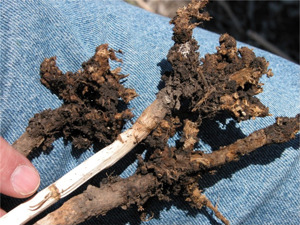
Features
Fungicides
Seed & Chemical
Identify leaf symptoms properly so you don’t spray unnecessarily
It may seem like a simple statement, but the truth is some growers do spray when there is no need.
November 27, 2007 By Rosalie I. Tennison
 |
| Bacterial blight can show up on many cereal crops during wet weather. Photos Courtesy Of Manitoba Agriculture and Rural Initiatives. |
Listen to the casual talk and you know that growers do not like to spend money
needlessly on herbicide or fungicide sprays if they can avoid it. After all,
these products cost money and, while they can save a crop, they also increase
the cost to grow it. So, why would any grower spray unnecessarily? Some do and
it could be merely because they are in a hurry to fix a problem that, if they
took the time to check, may not exist.
An example of this occurred in 2004 in southwestern Manitoba. The cereal crops
were looking healthy until some growers noticed some brown spots on the leaves.
Believing that a leaf disease was attacking the crop, they immediately sprayed
with a fungicide. In fact, the problem was due to a micronutrient deficiency
and likely would not have greatly affected the yield if ignored.
"There are many problems that may cause a change in the colour of the
leaves in your crop," says Scott Day, an agricultural representative with
Manitoba Agriculture, Food and Rural Initiatives in southwestern Manitoba. "It's
possible that no spray is needed for whatever is causing this problem."
David Kaminski, Manitoba's provincial field crop pathologist backs up Day's
advice. "The first caution I give every grower is: 'visual symptoms can
be misleading'," he says. "At first blush, many physical symptoms
can be misdiagnosed. Always get a second opinion."
Kaminski suggests getting a second opinion could save money. Help is available
from Crop Diagnostic Centres in each province that can make a firm diagnosis
from a tissue sample in less than a week. While it is true that most problems
can be diagnosed visually without taking that step, you really have to know
what you are looking at, and getting help can confirm or disprove your theory
of the problem.
In the case of the Manitoba 'disease', the brown spots were due to physiological
leaf spot, which is common in some varieties of winter and durum wheat. It is
a 'genetic predisposition', according to Kaminski. The spots appear due to a
lack of chloride and can be prevented with a seed-placed application of potassium
chloride (KCl). Kaminski says by the time the problem was noted, it was too
late to adjust the fertility, but treating with a fungicide did not solve the
problem and only added from $15 to $20 to the cost of growing the crop.
"This physiological problem shows up often in ideal growing conditions,"
Kaminski explains, "but it is often under these conditions that lack of
micronutrients is magnified. Physiological leaf spot appears at the top of the
plant first. Whereas, pathogens generally move up the plant from the bottom,
so the symptoms appear near the base of the plant." It is knowledge of
the symptoms that makes diagnosis easier, and that is why Kaminski and Day suggest
eliciting the help of an agronomist for a second opinion.
"Physiological leaf spot is eye catching, but it is not debilitating,"
adds Kaminski. "Many growers know which varieties are predisposed to the
condition and they know that losses can be small." In the case of a fungal
problem, he continues, the disease is progressive and will have an impact on
grain quality and quantity if left unchecked. The challenge in the diagnosis
is recognizing that more than one problem may appear at the same time. Again,
Kaminski stresses the value of a second opinion.
Day adds that bacterial blight can also show up on many cereal crops during
periods of wet weather. Although it does have many of the same characteristics
associated with common fungal diseases, blight creates the unique characteristic
of a shiny leaf surface like it has been varnished. Once again, he says, because
it is not fungal in nature, an application of a fungicide does nothing to correct
or prevent this problem. Bacterial blight is most prevalent in oats and like
physiological leaf spot, the effect on yield is often much less than what a
grower would expect from the amount of visible damage to the leaves.
Finally, Day reminds growers that wet weather, such as what was experienced
in areas of the prairies in 2005, can bring on disease, but it may not always
affect yield. "Even if a second opinion reassures you that a diagnosis
of a fungal disease is accurate, you should determine how serious the problem
is before spending money on a fungicide."
With thin profit margins, vigilant growers know that spending money unnecessarily
never improves the bottom line. Using the Manitoba case as an example, both
Day and Kaminski cannot stress enough that being sure of the problem is the
best way to protect your profits and your crop.